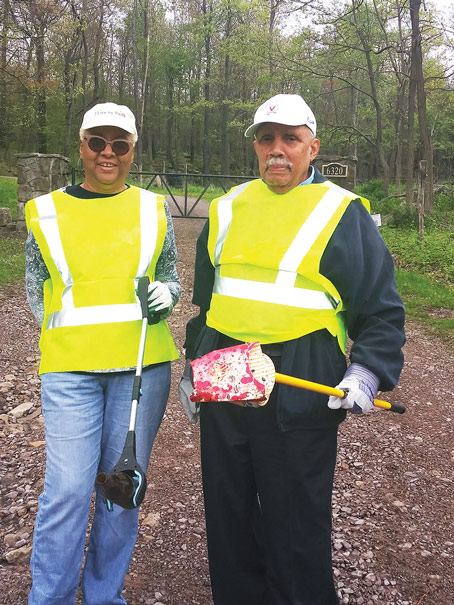MEMBERS OF THE EDNA B. MCKENZIE BRANCH of the Association for the Study of African American Life and History, at Negro Mountain, May 11.
by Alonna J. Carter, For New Pittsburgh Courier
On May 11, members of the Edna B. McKenzie branch of the Association for the Study of African American Life and History (ASALH) traveled to Negro Mountain in Garrett County, Maryland, to clean the area of litter, while always respecting the significance of this space in African American history.
The Edna B. McKenzie branch is based in Pittsburgh and adopted a portion of the highway that runs through Negro Mountain in 2018. Our branch cleans it four times each year.
The upkeep of Negro Mountain is just one of the projects that our group has taken on.
Our organization offers many efforts to educate the public about the places and issues that have affected people of African American descent, and to preserve sites of historical significance. Though we are not the first group to take up the effort, our group is diligent in ensuring the area stays clean and that the public is educated about the free African American man for which the mountain is named: Nemesis.
Nemesis was traveling with a White frontiersman named Thomas Cresap and others when he was killed during a skirmish with a local Native American tribe. Cresap was killed as well, and the mountain was named to honor Nemesis due to his bravery during the fighting, albeit alluding to his race rather than his actual name. The historical account of the event can be found in the June 15, 1756 issue of The Maryland Gazette, where it states: “A free Negro who was with the English, was killed in that Thicket where the wounded Indian retired, when Mr. Thomas Cresap was killed…”

There is also mention of the incident in a 1756 edition of The Pennsylvania Gazette, although Nemesis is neither named nor mentioned.
No other information about Nemesis’ origins or how he acquired free status in the early years of American slavery is known. This situation is not uncommon; details about people of African descent were often obscured from the record. Additionally, as with many events in American history that involve a person of color, the mountain has been the subject of controversy—both due to the name, and the events that took place there.
Edna B. McKenzie branch president Ronald B. Saunders thinks that to debate Nemesis’ actions in 1756 is moot. “How can any intelligent person living in the 21st century condemn Nemesis, who was trying to survive in the 18th century?” he asked. “Any 21st century value judgement on Nemesis must be done with keen, acute understanding and appreciation for the history of that period which often placed Africans, First America Indigenous, and European settlers at odds over interests.”
In an age where monuments to the Confederacy have been felled by a conscious effort to acknowledge the wrongs of the past, Negro Mountain has also had its fair share of scrutiny. Some view the word “negro” as an antiquated and offensive term that should be removed from the “Negro Mountain” name. Others understand it as a historical attribution and avenue for people to find out what the place is truly all about. There have been attempts to change the name, but the name “Negro Mountain” remains—a symbol of the complexities of America’s relationship with race.
Two hundred sixty-three years after Nemesis and Thomas Cresap met their fate, Negro Mountain is marked by a small placard in a picnic area complete with tables and stone grills on the Maryland side. As you may know, Negro Mountain is a 30-mile ridge of the Allegheny Mountains, stretching from Deep Creek Lake in Maryland, north to Pennsylvania’s Casselman River. The area is still surrounded by the verdant and dense woodland that the men would have encountered in the Pre-Revolutionary War era. Being out in the open and a small space, the area is prone to littering and dumping. However, members of ASALH encountered only small amounts of trash and garbage during our trip, showing that the area is being used, and that perhaps more people are learning about the story of an 18th-century African American pioneer.

After cleaning up, the group traveled to Mount Davis, which is the summit of Negro Mountain, at a height of 3,213 feet, also the highest point in Pennsylvania. Many of our members climbed to the top of the observation tower to experience the breathtaking views. From Pittsburgh, Mount Davis is about 85 miles to the southeast. Our organization plans to return to Negro Mountain a few more times this year.
Marlene Bransom, president of the Pittsburgh Chapter of the African American Historical and Genealogical Society (AAHGS) and a member of ASALH, described the experience as feeling like, “I was in heaven.”
(Alonna J. Carter is historian of the Edna B. McKenzie Branch of ASALH.)
Like us at https://www.facebook.com/pages/New-Pittsburgh-Courier/143866755628836?ref=hl
Follow @NewPghCourier on Twitter https://twitter.com/NewPghCourier